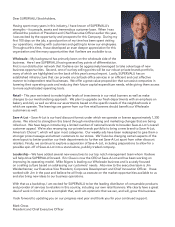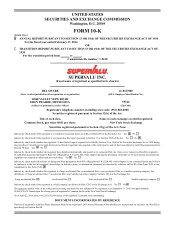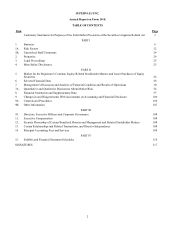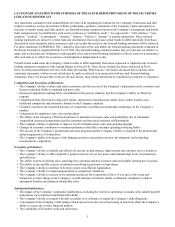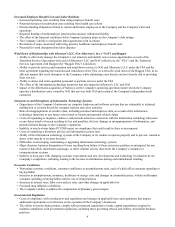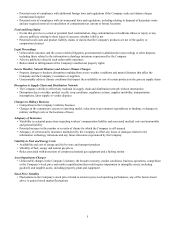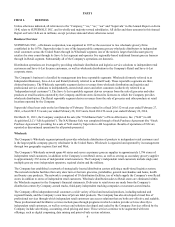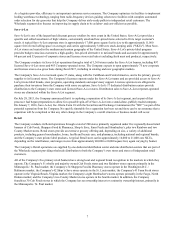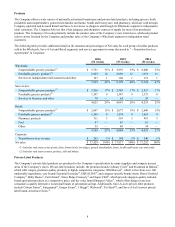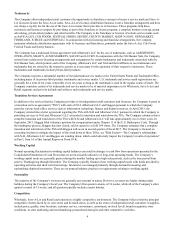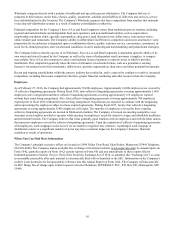Albertsons 2016 Annual Report Download - page 12
Download and view the complete annual report
Please find page 12 of the 2016 Albertsons annual report below. You can navigate through the pages in the report by either clicking on the pages listed below, or by using the keyword search tool below to find specific information within the annual report.
10
Wholesale competes directly with a number of traditional and specialty grocery wholesalers. The Company believes it
competes in this business on the basis of price, quality, assortment, schedule and reliability of deliveries and services, service
fees and distribution facility locations. The Company's Wholesale segment also faces competition from retailers that maintain
or develop self-distribution systems as a result of industry consolidation or otherwise.
Principal competition for the Company’s Save-A-Lot and Retail segments comes from traditional grocery retailers, including
regional and national chains and independent food store operators, and non-traditional retailers, such as supercenters,
membership warehouse clubs, specialty supermarkets, drug stores, hard discount stores, dollar stores, convenience stores,
online retailers and restaurants. The Company's ability to differentiate itself from its competitors and create an attractive value
proposition for its customers is dependent upon a combination of price, quality, customer service, convenience, assortment, in-
stock levels, brand perception, store location and conditions, in-store marketing and merchandising and promotional strategies.
The Company believes that the success of its Wholesale, Save-A-Lot and Retail segments is dependent upon the ability of its
own stores and stores licensed by the Company, as well as the stores of independent retail customers it supplies, to compete
successfully. Save-A-Lot also competes to attract and maintain licensed operators to operate stores to which it provides
distribution. This competition generally takes the form of alternative investment formats, such as a potential or existing
licensee’s investment in fast food restaurants, dollar stores, specialty supermarkets, drug stores and other potential investments.
Recent and ongoing consolidation within the grocery industry has resulted in, and is expected to continue to result in, increased
competition, including from some competitors that have greater financial, marketing and other resources than the Company.
Employees
As of February 27, 2016, the Company had approximately 38,000 employees. Approximately 16,000 employees are covered by
55 collective bargaining agreements. During fiscal 2016, nine collective bargaining agreements covering approximately 1,600
employees were renegotiated and three collective bargaining agreements covering approximately 110 employees expired
without their terms being renegotiated. Also, four collective bargaining agreements covering approximately 700 employees
expired prior to fiscal 2016 without their terms being renegotiated. Negotiations are expected to continue with the bargaining
units representing the employees subject to those expired agreements. During fiscal 2017, twenty-four collective bargaining
agreements covering approximately 8,400 employees will expire. The majority of employees covered by these expiring
collective bargaining agreements are located in Midwestern markets. The Company is focused on ensuring competitive cost
structures in each market in which it operates while meeting its employees’ needs for attractive wages and affordable healthcare
and retirement benefits. The Company believes that it has generally good relations with its employees and with the labor unions
that represent employees covered by collective bargaining agreements. Upon the expiration of collective bargaining agreements
with employees, work stoppages could occur if we are unable to negotiate new contracts. A prolonged work stoppage at
distribution centers or a significant number of stores may have a material impact on the Company’s business, financial
condition or results of operations.
Where You Can Find More Information
The Company’s principal executive offices are located at 11840 Valley View Road, Eden Prairie, Minnesota 55344 (Telephone:
952-828-4000). The Company makes available free of charge at its Internet website (www.supervalu.com) its annual reports on
Form 10-K, quarterly reports on Form 10-Q, current reports on Form 8-K and any amendments to these reports filed or
furnished pursuant to Section 13(a) or 15(d) of the Securities Exchange Act of 1934, as amended (the “Exchange Act”) as soon
as reasonably practicable after such material is electronically filed with or furnished to the SEC. Information on the Company’s
website is not deemed to be incorporated by reference into this Annual Report on Form 10-K. The Company will also provide
its SEC filings free of charge upon written request to Investor Relations, SUPERVALU INC., P.O. Box 990, Minneapolis, MN
55440.


